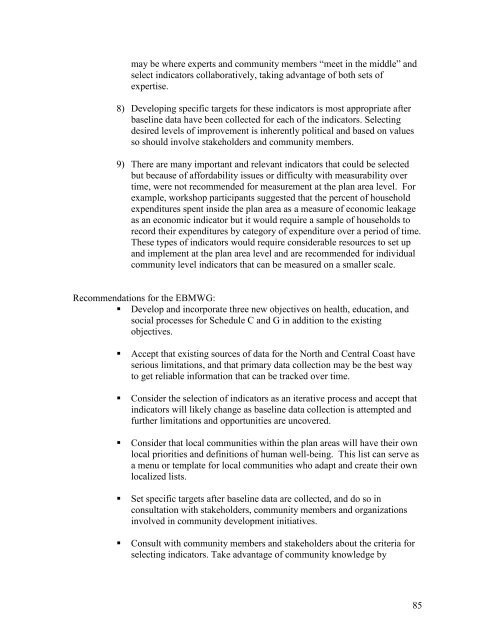Final report - Integrated Land Management Bureau
Final report - Integrated Land Management Bureau
Final report - Integrated Land Management Bureau
You also want an ePaper? Increase the reach of your titles
YUMPU automatically turns print PDFs into web optimized ePapers that Google loves.
may be where experts and community members “meet in the middle” and<br />
select indicators collaboratively, taking advantage of both sets of<br />
expertise.<br />
8) Developing specific targets for these indicators is most appropriate after<br />
baseline data have been collected for each of the indicators. Selecting<br />
desired levels of improvement is inherently political and based on values<br />
so should involve stakeholders and community members.<br />
9) There are many important and relevant indicators that could be selected<br />
but because of affordability issues or difficulty with measurability over<br />
time, were not recommended for measurement at the plan area level. For<br />
example, workshop participants suggested that the percent of household<br />
expenditures spent inside the plan area as a measure of economic leakage<br />
as an economic indicator but it would require a sample of households to<br />
record their expenditures by category of expenditure over a period of time.<br />
These types of indicators would require considerable resources to set up<br />
and implement at the plan area level and are recommended for individual<br />
community level indicators that can be measured on a smaller scale.<br />
Recommendations for the EBMWG:<br />
Develop and incorporate three new objectives on health, education, and<br />
social processes for Schedule C and G in addition to the existing<br />
objectives.<br />
Accept that existing sources of data for the North and Central Coast have<br />
serious limitations, and that primary data collection may be the best way<br />
to get reliable information that can be tracked over time.<br />
Consider the selection of indicators as an iterative process and accept that<br />
indicators will likely change as baseline data collection is attempted and<br />
further limitations and opportunities are uncovered.<br />
Consider that local communities within the plan areas will have their own<br />
local priorities and definitions of human well-being. This list can serve as<br />
a menu or template for local communities who adapt and create their own<br />
localized lists.<br />
Set specific targets after baseline data are collected, and do so in<br />
consultation with stakeholders, community members and organizations<br />
involved in community development initiatives.<br />
Consult with community members and stakeholders about the criteria for<br />
selecting indicators. Take advantage of community knowledge by<br />
85
















